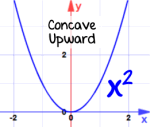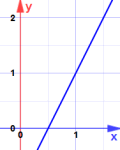上凹还是下凹,叫法相反的凹函数 Concave Upward and Downward
来源:互联网 发布:淘宝刷信用卡套现 编辑:程序博客网 时间:2024/04/28 01:26
Concave Upward and Downward
Concave upward is when the slope increases: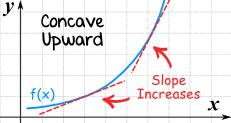 Concave downward is when the slope decreases:
Concave downward is when the slope decreases: 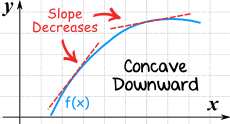
What about when the slope stays the same (straight line)? It could be both! See footnote.
Here are some more examples:
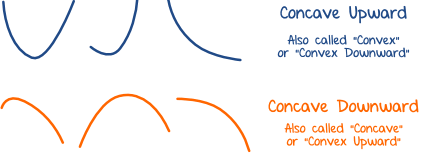
Concave Downward is also called Concave or Convex Upward
Concave Upward is also called Convex or Convex Downward
Finding where ...
Usually our task is to find where a curve is concave upward or concave downward:
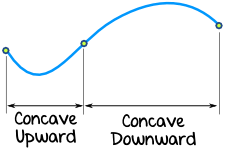
Definition
The key point is that a line drawn between any two points on the curve won't cross over the curve:

Let's make a formula for that!
First, the line: take any two different values a and b (in the interval we are looking at):
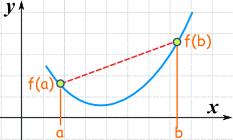
Then "slide" between a and b using a value t (which is from 0 to 1):
x = ta + (1−t)b
- When t=0 we get x = 0a+1b = b
- When t=1 we get x = 1a+0b = a
- When t is between 0 and 1 we get values between a and b
Now work out the heights at that x-value:
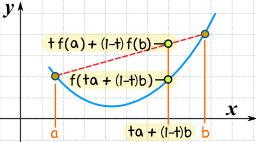
When x = ta + (1−t)b:
- The curve is at y = f( ta + (1−t)b )
- The line is at y = tf(a) + (1−t)f(b)
And (for concave upward) the line should not be below the curve:

For concave downward the line should not be above the curve (≤ becomes ≥):
![]()
And those are the actual definitions of concave upward and concave downward.
Remembering
Which way is which? Think:

Concave Upwards = CUP
Calculus
Derivatives can help! The derivative of a function gives the slope.
- When the slope continually increases, the function is concave upward.
- When the slope continually decreases, the function is concave downward.
Taking the second derivative actually tells us if the slope continually increases or decreases.
- When the second derivative is positive, the function is concave upward.
- When the second derivative is negative, the function is concave downward.
Footnote: Slope Stays the Same
What about when the slope stays the same (straight line)?
Saying Strictly Concave upward or Strictly Concave downward means a straight line is not OK.
Otherwise a straight line is acceptable for both.
- 上凹还是下凹,叫法相反的凹函数 Concave Upward and Downward
- 维基百科中凹函数的定义 Concave function
- 凸函数和凹函数在国内和国外的一些定义是相反的 Convex function和Concave Function
- 经济学原理中的数学: 凹函数和凸函数 Concave and convex functions of a single variable
- 凹函数和凸函数,Concave Function和Convex Function
- 凹函数与凸函数
- 凹函数和凸函数
- 订残页的if活心,凹
- 在父对话框上创建凹下/凸起的子对话框样式
- 关于表格凸起和凹下的设计
- java中设置文本框下凹的感觉
- 利用3分法求凸(凹)函数极值
- MFC SS_Sunken 下凹 代码发布
- 凸多边形和凹多边形的判断
- 凹、凸多边形判定
- 凹多边形画法
- 凹数科技笔试
- 凸,凹多边形定义
- Apache服务器最新版下载、安装及配置(win版)
- 设计模式第二节:Factory Method(工厂方法)
- 如何更高效的使用MVP以及官方MVP架构解析
- html的meta总结,html标签中meta属性使用介绍
- 理解CALayer中position与anchorPoint属性
- 上凹还是下凹,叫法相反的凹函数 Concave Upward and Downward
- sparkStreming on HDFS
- 正则表达式语法
- CString用法大全
- 由__futex_syscall3略微展开
- CSS边框
- SparkStreaming数据源Flume
- Unix & Linux 笔记(10)
- Shiro的Demo示例
